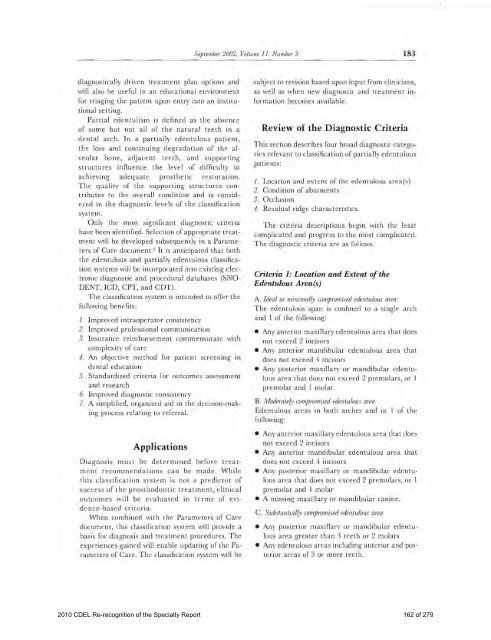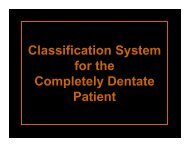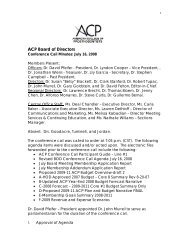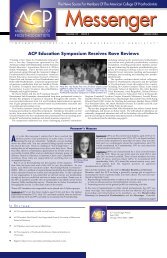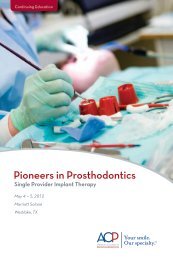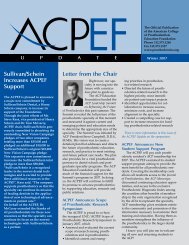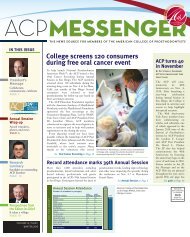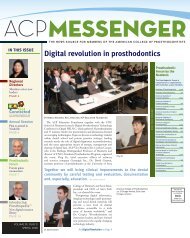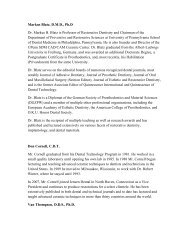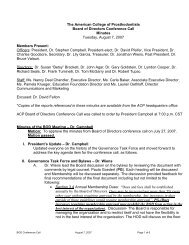PROSTHODONTICS - American College of Prosthodontists
PROSTHODONTICS - American College of Prosthodontists
PROSTHODONTICS - American College of Prosthodontists
You also want an ePaper? Increase the reach of your titles
YUMPU automatically turns print PDFs into web optimized ePapers that Google loves.
September 2002, Volume I I, Number 3183diagnostically driven treatment plan options andwill also be useful in an educational environmentfor triaging the patient upon entry into an institutionalsetting.Partial edentulism is defined as the absence<strong>of</strong> some bu t not all <strong>of</strong> the natu ral tee th in adental arch. In a partially edentulous patient,the loss and continuing degradation <strong>of</strong> the alveolarbone, adjacent teeth, and supportingstructures influence the leve l <strong>of</strong> difficulty inachieving adequate prosthetic restoration.The quality <strong>of</strong> the supporting structures contributesto the overall condition and is considered in the diagnostic levels <strong>of</strong> the classificationsystem.Only the most significant diagnostic criteriahave been id entified. Selection <strong>of</strong>appropriate treatment will be developed subsequently in a Parameters<strong>of</strong> Care document 3 It is anticipated that boththe edentulous and partially edentulous classificationsys tems will be incorporated into existing electronicdiagnostic and procedural databases (SNODENT, lCD, CPT, and CDT).The classification system is intended to <strong>of</strong>fer thefollowing benefits:1. Improved intraoperator consis tency2. Improved pr<strong>of</strong>essional communication3. Insurance reimbursement commensurate withcomplexity <strong>of</strong> care4. An objective method for patient screening indental education5. Standardized criteria far outcomes assessmentand research6. Improved diagnostic consistency7. A simplified, organized aid in the decision-makingprocess relating to referral.ApplicationsDiagnos is must be determined before treatment recommendations can be made. Whilethis classification sys tem is not a predictor <strong>of</strong>success <strong>of</strong> the pros thodon ti c trea tmen t, clinicalou tcomes will be evaluated in terms <strong>of</strong> evidence-based criteria.When combined with the Parameters <strong>of</strong> Caredocument, this cl ass ification sys tem will provide abasis for diagnos is and treatment procedures. Theexperiences gained \"ill enable updating <strong>of</strong> the Parameters<strong>of</strong> Care. The classification system will besu bject to revision based upon inpu t from clinicians,as well as when new diagnostic and treatment informationbecomes available.Review <strong>of</strong> the Diagnostic CriteriaThis section describes four broad diagnostic categoriesrelevant to classification <strong>of</strong> partially edentulouspatients:1. Location and exten t <strong>of</strong> the edentulous area(s)2. Condition <strong>of</strong> abutments3. O cclusion4. Residual ridge characteristics.The criteria descriptions begin with the leas tcomplicated and progress to the most complicated.The diagnostic criteria are as follows.Criteria 1.- Location and Extent <strong>of</strong> theEdentulous Area(s)A. Ideal or minimally compromised edentulous areaThe edentulous span is confined to a single archand I <strong>of</strong> the following:• Any anterior maxillary edentulous area that doesnot exceed 2 incisors• Any anterior mandibular edentulous area thatdoes not exceed 4 incisors• Any posterior maxillary or mandibular edentulousarea that does not exceed 2 premolars, or Ipremolar and 1 molar.B. Moderately compromised edentulous areaEdentulous areas in both arches and in I <strong>of</strong> thefollowing:• Any anterior maxillary edentulous area that doesnot exceed 2 incisors• Any anterior mandibular edentulous area thatdoes not exceed 4 incisors• Any posterior maxillary or mandibular edentulousarea that does not exceed 2 premolars, or 1premolar and I molar• A missing m axill ary or mandibular canin e.C. Substantially compromised edentulous area• Any posterior m axillary or mandibular edentulousarea greate r than 3 teeth or 2 molars• Any edentulous areas including anterior and posteriorareas <strong>of</strong> 3 or more teeth.2010 CDEL Re-recognition <strong>of</strong> the Specialty Report 162 <strong>of</strong> 279


